- 1864 Richmond Carbine Full View & Ram Rod
- 1864 Richmond Carbine Stock
- 1864 Richmond Carbine Barrel and Ram Rod
- 1864 Richmond Carbine Hammer & Lock Plate
- 1864 Richmond Carbine Lock Plate
- 1864 Richmond Carbine CS Richmond, VA Stamp
- 1864 Richmond Carbine Rear Sight Cut For Steady Pin
- 1864 Richmond Carbine VP & Eagle Inspection Stamp
- 1864 Richmond Carbine Lock Plate & Exposed Cavity
- 1864 Richmond Carbine Back Of Lock Plate
- 1864 Richmond Carbine Lock Plate Cavity
- 1864 Richmond Carbine Barrel Band Off Set U
- 1864 Richmond Carbine Barrel Band Sling Off Set U
- 1864 Richmond Carbine Front Sight, Filed
- 1864 Richmond Carbine Rear Sling Swivel
- 1864 Richmond Carbine Brass Butt Plate
- 1864 Richmond Carbine Left Side
Finally a 1864 Richmond that was affordable enough to add to the ever growing Civil War Arsenal. This fine Richmond Armory weapon is 100% Southern manufactured. The stock has no cut out for the Maynard Primer system on the mule’s foot, suggesting that it is wood that was shipped up from Macon Georgia and shaped in Richmond Virginia.
The lock plate has a nice brown patina with fine markings that we like to see on these models. The barrel also has a brown patina with clear V.P. and eagle inspection markings however their is no date stamped. The rear sight is missing however it does have the cut for the steady pin which holds the sight straight. The only problem with the barrel is the front sight has been filed down, however based on the color it was done a very long time ago.
The barrel bands are both stamped with the off set U (for up) which tells us they were hand stamped at the Richmond Armory, however the front barrel band is missing its sling and unlike most Richmond Carbines that are missing the rear sling that screws into the stock this one has its correct one. The butt plate and the nose cap are both brass which is common amongst 1864 Richmonds.
If you haven’t noticed by now I should tell you I love these Richmond Armory weapons. I can’t seem to get enough of them. Each and every one tells its own story, I guess that’s what fascinates me about them.
I’m hoping to add more late model Richmonds to my collection over the next year. It’s my opinion that the late 1863 and 1864 models with there brass butt plates and Macon Ga. stocks tell great stories and show case well. So with any luck you will see my collection grow with those models and if I get really lucky I just may have the opportunity to add more short rifles to my collection. I think there my favorite, but like everything else that changes with time.
Thanks for stopping by and reading my garble. I hope you enjoy the photo’s and if you have a Richmond no matter what year or condition and want to sell it, shoot me an email at civilwararsenal@yahoo.com attn Eugene West

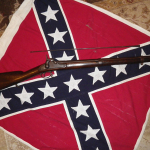
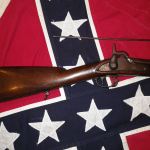
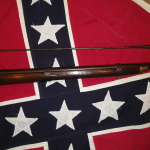
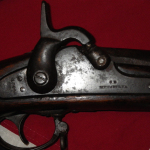
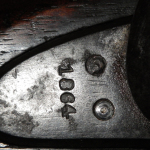
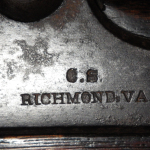
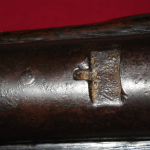
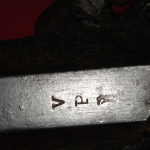
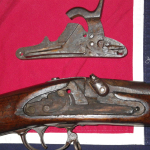
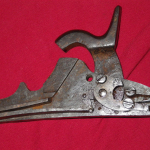
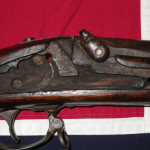
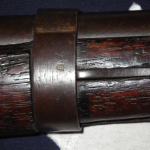
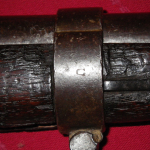
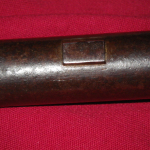
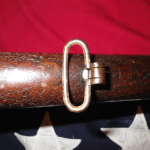
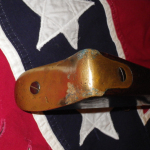
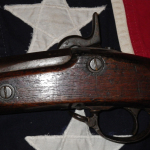
HELLO seen your site I have a 1864 Richmond carbine rifle for sale if you are interested please give me a call 708-aaa-aaaa ask for MIKE thank you
Gene,
Many thanks, this helps a lot, and good luck with your endeavors also!
Thanks again for the great web site!
Joe
From: Eugene West [mailto:genx1969@yahoo.com]
Sent: Tuesday, November 11, 2014 12:50 PM
To: Steven Owen
Subject: Re: Carbine questions for Eugene West
Joe,
The diameter of the barrels at the muzzle are the same, however the diameter throughout the length of a 40′ and 33″ are different from the carbine.
Example: If you were to sit a carbine barrel in the cradle of a long rifle stock it would be slightly smaller in diameter (at 25″) in relation to the same area (25″) of the diameter of a 40″ barrel. Likewise if you were to sit a 40″ barrel into the cradle of a carbine stock the area of the barrel that lays into the brass nose cap would not fit due to it being larger in diameter. I hope all that makes sense.
You are correct by saying the muzzle end of the stocks were quickly tapered to allow fitting of the nose caps.
As far as the tension spoon for the ram rods go, I’ve seen Richmond’s with and without them. Because many Richmond rifles were made from a collection of confiscated parts and battlefield pick ups its fair to say that some had the spoon and some didn’t.
Ram rods that were manufactured in Richmond were slightly smaller in diameter then Union counter parts and they were not swelled. But I’ve seen dozens of Richmond’s with swelled ram rods. I gather they were picked up from battlefields, replaced do to them being bent (remember they were slightly thinner and much more flexible/fragile), and many of these rifles were used as shooters after the war (for utilitarian use) and parts were broken and replaced with whatever was available.
Its my opinion that late war Richmond long rifles made with wood that was brought up from Macon Georgia would NOT have a spoon do to the lack of steel and wood. There would have been an urgency to get any many rifles to the front lines at the risk of them not having a spoon. Again that’s only my opinion. I guess I need to do more research in this department.
Good luck with your project, Gene
From: Steven Owen
To: Eugene West
Sent: Tuesday, November 11, 2014 8:29 AM
Subject: RE: Carbine questions for Eugene West
Hey Gene,
Thanks for the reply, sure appreciate your time. I love talking old guns better than eating ice cream! I am trying to make a re-enactor shooter Richmond carbine styled after the earliest versions and trying to figure out the barrel diameters without having one to go by. Making a gun from pictures is like hunting for your car keys in the dark without a flashlight. Right now the funds just don’t exist to purchase an original, and it’s a great love of mine to carve out rifles from scratch anyway. I learn so much from digging for minor details.
The few rifles I’ve made are marked indelibly with my name and marked in different places so there will never be confusion as to the fact they are modern “re-issue”. It’s important to me to preserve the originals and not tear them up shooting them, but also to preserve the integrity and respect of the old generation of guys who made and used these guns.
I make 100% of the parts myself from butt plate forging, hammers, lock plate, barrels, sights, & bands to machining nose caps. Even make all the different screws. It’s been a wonderful experience over the years and gives me a huge respect for the old armory guys who made stuff so close tolerance without the equipment we’ve got today. Just amazing.
That’s why I want to make my guns as accurate as possible to originals but at the same time make sure they cannot be changed into ‘fakes” and sold as originals. The idea is to see what it was like to shoot these guns without the damage to the originals. I’ve never sold any, in fact I’m afraid to. Somebody would blow their toe off and I’d get sued for everything I’ve got for being the one who made the “evil” gun.
I suspected they did make a special barrel for these early made 25” barrel carbines from info from Paul Davies book, but if I remember right it doesn’t go into a lot of detail on the size difference.
If you don’t mind my asking, is the muzzle diameter at the very end on the 25” barrels different than the 33” barrels or the cut down from 40” barrels? If the barrel bands from a Richmond rifle musket fit, the barrel diameters where the bands go on the 25” must be pretty close to the 40” at least at the band areas?
From pictures it looks like the wood on the carbine is “quickly” tapered from the top swiveled band to the nose cap. I’m guessing this is because the wood has to be large enough to accommodate the swivel band yet be reduced to the nose cap diameter in a short distance. Makes sense?
That’s another area of interest, I didn’t know the Richmond long rifle had a ram rod spoon or tongue. I know the Model ’63 Springfield’s had them. It’s been hard to nail down exact info on the ram rods whether they were straight or swelled.
I’m guessing the early Harpers Ferry stocks already had a ram rod swell in the stock and there were captured swelled ram rods. Did they go to the tongue after the swelled ram rods were used up?
Anyway, thanks again for your time and the info. Hope you don’t mind all the questions. It’s always great “talking” to a fellow Civil War “gun nut”!
Joe
From: Eugene West [mailto:genx1969@yahoo.com]
Sent: Monday, November 10, 2014 6:48 PM
To: Steven Owen
Subject: Re: Carbine questions for Eugene West
Joe,
You pose some interesting questions about Richmond Carbines. It’s true that some barrels were cut down from 40″ but most of them were either for short rifles with a 33″ barrel or Springfield’s that were cut down as carbines (25″ barrels), but they would have a springfield lock plate. I have never seen a Richmond Carbine ( with a Richmond lock plate ) with a cut down barrel. But that doesn’t mean they don’t exist, if they do if would be a late war carbine probably late 63 thru 64 and till the end of the war. Barrels that were cut down would not have the diameters re shaped, it would have been easier for the mechanics to reshape the wood instead. You have to keep in mind the limited resources the South had, and the only reason they had the equipment to manufacture Richmond weapons was due to Stonewall Jackson’s raid on the Harpers Ferry Arsenal in April of 1861.
As far as the nose caps are concerned, by the time the Richmond Armory started making Carbines (March/April of 1862) they had used up all the ones that were confiscated during S. Jacksons raid at Harpers Ferry so they had local Richmond contractors manufacture them. They are a bit crude with many flaws in them. The bottom of the cap is not notched like there long rifle counter parts this is because it is designed to put tension on the ram rod and keep it in place, long rifles have a tongue located in the stock under the barrel in front of the lock plate that holds the ram rod.
The nose caps are about the same size as a nose cap for a long rifle. Instead of resizing the cap the mechanics re sized the wood stock to fit the caps, like I had stated earlier with the barrels. It was easier for the agrarian workers to reshape the wood stocks then to cut metal and brass due to them not having the tools and resources. And yes the barrel bands from a long rifle will fit a carbine.
Let me not forget to mention that the Richmond Armory did not have the tools to rivet the nose cap in place like the Harpers Ferry, Springfield and Enfields. The nose caps are screwed on, which is one of the things any collector looks for when examining a Richmond, carbine, short rifle or long rifle.
Hope that answers all your questions, and thanks for checking out the Civil War Arsenal.
Gene
Sent from my iPad
On Nov 10, 2014, at 9:41 AM, Steven Owen wrote:
Hello Mr.West,
First off thanks very much for putting forth the effort to photograph and document some of your Richmond carbine finds. I particularly enjoyed the story of the Gettysburg find and the lucky strike of finding a hidden name on it. That has to be like a once in a life time cool thing to do!
I don’t have anything to sell, but I would love to beg a little of your time if you don’t mind and ask you a few question I’ve been trying to find the answer to about the carbines.
I’ve read where the 40” barrels were simply cut to 25” on some, but apparently the barrels weren’t cut down in diameter. Is this true?
If not cut down, what did they do to accommodate the bands and the nose caps because if they were moved closer to the breech on the carbines, the old bands & nose cap won’t fit, right?
Do you know if they used existing brass nose caps & bands and enlarged them, or did they fabricate different ones to fit the new barrel & wood diameters?
Thank you very much for your time, much appreciated!
Joe Owen
the 1 band is tight and I am not sure of damaging if I try to remove to see if there are any marks on base of barrel the marks seem to puzzle myself the one side is a”HFH” I ASSUME SOMETING TO DO WITH HARPES FERRY.The other side seems to be a series of t” upside down and right side up? I do know this is a rare piece and would demand a very good number if to come up in auction yes I would consider a sale but the number would have to be a good one thanks for your help.
RON
Received the photos of the Richmond Rifle Musket you forwarded…. I’m assuming you got my email address from my web site Civil War Arsenal. It seems as though this is an authentic Richmond Rifle, however there are some questionable details that I would have to research.
The barrel has some markings on it that I’m not really certain of…..maybe you can take better quality photos (high resolution) so I can better research…the markings that I’m concerned about are the ones by the breech of the barrel 1. Under the proof marks VP and eagle on the left side of the barrel…2. On the right side of the barrel over the lock plate.
1. It would be helpful to remove the barrel from the stock and photo the area of the stock where the brass nose cap is attached…..is it attached with a rivet or a screw?
2. Also photo the area of the barrel where the breech plug is screwed in, there may be proofs marks that will determine if it is a Union barrel or a Southern made barrel.
3. Take close up photos of the barrel bands while attached to the stock….need to see the U in relation to the barrel band catch/locking device.
Are you interested in selling the rifle?
Let me know if you have any questions and I will do my best to answer any and all.
Ron, I believe the barrel on your rifle is a Union made barrel…to authenticate the barrel you have to remove it from the stock…. I understand it’s tight and yes you’ll have to be careful but to understand the circumstances of the weapon it’s a must.
I currently own 8 Richmond rifles of all types… Even though all are similar each one is different due to the situation in the South during the war. I’ve handled dozens of Richmond’s over the years as well as other Confederate weapons and I can almost certainly tell you the Southern Armoires did not stamp there weapons with HFH or with TTTTTTT, neither did the Harpers Ferry Armory, and yes I own a handful of Harpers Ferry weapons.
It could very well be a Union barrel that was picked up from the battlefield and forwarded to the Richmond Armory. The latter part of the war the Richmond Armory suffered from deliveries of steel for barrels and walnut wood for stocks so in there frenzy of trying to make guns for the soldiers at the fronts they would use whatever resources they had. Which in many cases turned out to be Union parts on Confederate weapons.
Hopefully that helps you understand better what you have. I don’t think we can make a deal for your rifle musket, I believe your expectations may be unrealistic…..I get offered deals on Richmond’s all the time, after all it is the most common Confederate weapon available. I don’t over pay for them….so you should probably try to sell at auction….I don’t do auctions, I buy from dealers, collectors and enthusists.
Good Luck, Gene West
There are no markings under the barrel just shinny original finish al I see is a”0″ by the nipple.
You need to look very closely to the area where the breech plug is screwed into the barrel….you my have to use a magnify glass with lots of light…..Union made barrels will have proof marks, if there’s a “C” this means it’s a condemned Union barrel which is very cool….. Southern made barrels don’t usually have more then 1 proof mark, sometimes none at all.
Gene
Have carbine 1863 25 inch barrel has all the marking you refer to..l had this rifle 20 years. I would like more info on this rifle am willing to sell is there a number that i can get in touch with you. Has steel butt plate àn all the marking. From what i,am reading it a rear piece. John C.
Mr. West: I own a Confederate Richmond musket, dated 1863 on the lock plate. I bought the gun in the early 1970’s at the Lakeland, Florida gunshow, and have recently made a decision to possible sell it, as I am getting up in age, with two sons who have no interest whatsoever in such things, but I want to do some authentication before moving forward. In your article on the internet web site, Civil War Arsenal, you mentioned a “couple of reference books” on the market which would assist in the authentication of such rifles, and I would appreciate knowing the name of such books and the authors thereof, and, if you know, where I might be able to purchase a copy of those books. Your help with this will be greatly appreciated.
The book “C.S. Armory Richmond” by Paul Davies is a great reference for Richmond rifles of all sorts….the book is no longer in print but can still be gotten through book stores online…..here’s a link to one. https://www.trackofthewolf.com/Categories/PartDetail.aspx/274/1/BOOK-CSAR
There are others but this is considered the bible of Richmond’s……I have 8 Richmonds in my collection, most are on my blog site Civil War Arsenal, I would encourage you to study the photos provided in there posting…..it’s the best way to understand Richmond Rifles…..handle as many as you can or in your case study as many images as possible.
Feel free to ask whatever questions you may have……if your serious about selling it maybe you can provide photos and I can make an offer…..I’m in Florida, Sarasota area.
Mr West
Thanks for your prompt reply and for the information on the book. I will keep you in mind, as I travel down to the Fort Myers area several times a year in connection with my being a lawyer and an NRA firearms instructor who assists NRA counselors with teaching Florida and federal firearms law and lethal force issues under Florida law the their instructor students.